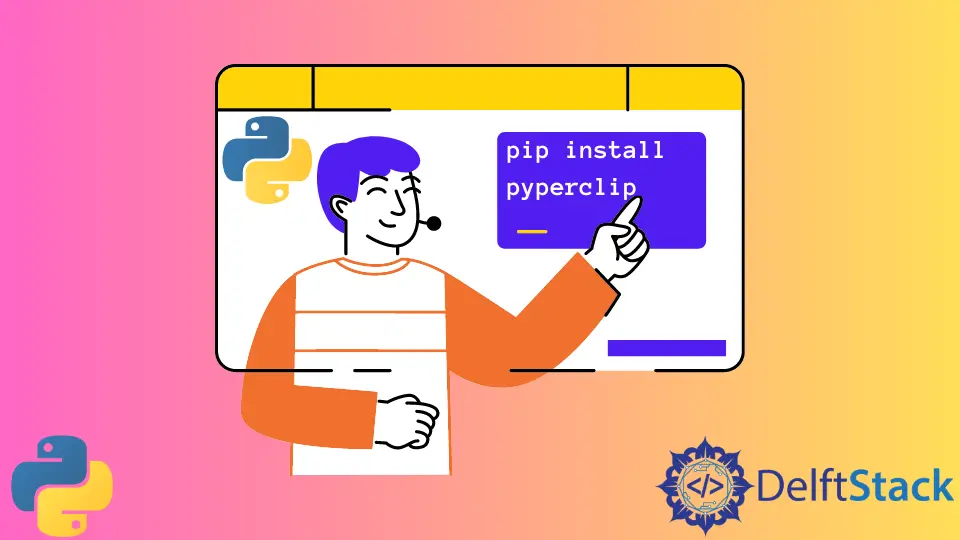How to Install Pyperclip in Python
-
Install
pyperclipUsingpip -
Install
pyperclipUsingpip3 -
Install
pyperclipUsingconda -
Manually Install the
pyperclipModule in Python -
Using the
pyperclipModule

This tutorial will discuss the methods to install pyperclip in Python.
When it comes to programming, an application’s user experience can be significantly improved by having seamless interaction with the clipboard. Text copying and pasting are frequent tasks, and Python developers can use the Pyperclip library’s capabilities to make clipboard operations more efficient on various platforms.
The pyperclip module is a cross-platform Python module that provides clipboard functionality, allowing developers to effortlessly integrate copy-and-paste functionality into their Python scripts.
The following command shows us how we can install the pyperclip module in Python.
Install pyperclip Using pip
Python’s package installer, pip, is used to install and manage third-party libraries and packages that are not included in the standard library. Recursively, pip stands for “Pip Installs Packages” or “Pip Installs Python”.
To install, open the command prompt and paste the command below.
pip install pyperclip
After executing this command in the terminal or command prompt, the pip package manager fetches the latest version of the pyperclip package from the Python Package Index (PyPI) and installs it in your Python environment.
Once installed, you can import and use the pyperclip module in your Python scripts to interact with the clipboard, allowing you to copy and paste text programmatically across different platforms, such as Windows, macOS, and Linux.
pip list
The command mentioned above lists all the Python packages installed on our machine.
Install pyperclip Using pip3
Python 3 is specifically linked with a particular version of the pip package installer called pip3.
It may be necessary to distinguish between the two versions of pip when you have both Python 2 and Python 3 installed on your system because they can coexist. While pip by itself could refer to the Python 2 version, the pip3 command is specifically used for Python 3.
Using pip3 ensures that the pyperclip package is installed in the Python 3 environment. This is especially important when working in environments where both Python 2 and Python 3 are present, as it helps avoid confusion and ensures that the package is installed for the correct Python version.
We install the pyperclip module with the pip3 package manager using the command below.
pip3 install pyperclip
Note: We cannot use libraries like
tkinterandpyperclipin the Jupyter Notebook.
Install pyperclip Using conda
Anaconda and Miniconda are distribution platforms for Python and other programming languages that are widely used in the data science, scientific computing, and machine learning communities. They are developed and maintained by Anaconda, Inc.
Conda is particularly useful for managing dependencies and environments in a more comprehensive way than pip, as it can handle not only Python packages but also packages from other languages and system-level dependencies.
So if you are using Anaconda or Miniconda, you can install pyperclip using the command below.
conda install -c conda-forge pyperclip
By executing this command, Conda will fetch the pyperclip package from the conda-forge channel and install it into the active Conda environment.
Manually Install the pyperclip Module in Python
Follow the steps below to install the pyperclip module in Python manually.
-
Manually download the
pyperclipfrom this link. -
Extract the downloaded file to
C:\Users\username\AppData\Local\Programs\Python\Pythonversion\Lib. -
Import the
pyperclipmodule in your Python code file.
Using the pyperclip Module
Once you have installed pyperclip, you can use it in your Python scripts by importing it and using its functions to interact with the clipboard.
Code Example:
import pyperclip
text = "Hello, clipboard!"
pyperclip.copy(text) # Copy text to clipboard
copied_text = pyperclip.paste() # Paste text from clipboard
print(copied_text)
The copy() function from Pyperclip is used to copy the content of the text variable to the clipboard.
The paste() function retrieves the current content of the clipboard and assigns it to the variable copied_text.
Output:
Hello, clipboard!
Finally, the content retrieved from the clipboard is printed to the console. In this specific example, it would print Hello, clipboard!.
Conclusion
With the pyperclip library, copying and pasting text is made easier in Python and can be done on any platform.
By following this tutorial, you’ve learned how to install pyperclip and integrate it into your Python scripts, improving the user experience of your applications.
The pyperclip provides an easy way to handle clipboard interactions when developing a graphical user interface or a command-line tool.
Maisam is a highly skilled and motivated Data Scientist. He has over 4 years of experience with Python programming language. He loves solving complex problems and sharing his results on the internet.
LinkedIn